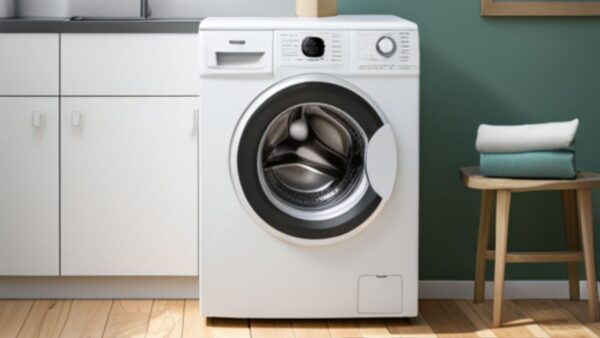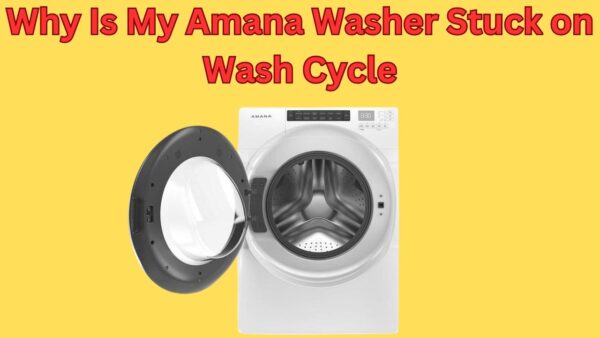Hi dear friends welcome to our blog. If your Washing Machine Smells of Stagnant Water.
So Don’t worry this is a common issue.
In this guide, we explain 10 common reasons for this problem with unique solutions. So let’s start now.
My Washing Machine Smells of Stagnant Water

1. Trapped Laundry Debris
Cause
Trapped laundry debris is a common issue that can lead to your washing machine smelling like stagnant water.
Over time, small pieces of clothing, lint, hair, and detergent residue can accumulate in the drum or drain hose.
This debris can become moldy if not removed, which can result in the unpleasant odor you’re experiencing.
Remember, your washing machine is a closed, damp environment, a perfect breeding ground for mold and mildew.
Solution
Fortunately, the solution for trapped laundry debris is simple and straightforward.
Start by running a hot cycle with a washing machine cleaner or a homemade solution of vinegar and baking soda.
This should help dissolve and dislodge any debris. For stubborn debris, you may need to manually clean the drum or hose.
Ensure to use gloves if you opt for manual cleaning to avoid any skin irritation.
Also, make it a routine to leave the machine’s door ajar after each use to allow the interior to dry out thoroughly, reducing the likelihood of mold growth.
2. Accumulated Detergent Residue
Cause
Accumulated detergent residue often occurs when excess detergent is used in the washing process.
This excess can fail to dissolve completely, resulting in a buildup on clothing and the interior of the washing machine.
Over time, this buildup can harm the machine’s efficiency and can leave clothing stiff and discolored.
Solution
To prevent and remove detergent residue, it is essential to use the correct amount of detergent per wash.
If a buildup is already present, a hot water cycle without any clothing can help dissolve and remove the residue.
Regular maintenance, including cleaning the drum and dispenser, can prevent future buildup.
Regularly using a detergent designed to clean washing machines can also be an effective preventive measure.
3. Blocked Drain Pump Filter
Cause
A blocked drain pump filter is often caused by foreign objects like coins, buttons, or hairpins getting into the washing machine, usually left in the pockets of clothing.
Over time, these items accumulate and obstruct the filter, preventing water from draining effectively.
Any sign of water not draining properly should be an immediate red flag signaling a possible blocked filter.
Solution
The solution comes in the form of regular maintenance and cleaning. Most washing machines have a small door near the bottom front with a drain pump filter inside.
By regularly cleaning this filter, you can prevent any blockage and maintain the optimal performance of your machine.
If the blockage persists after cleaning the filter, it is then advisable to consult with a professional to prevent further damage.
4. Stagnant Water in the Drum
Cause
Stagnant water in the drum can occur when the washing machine’s drainage system is blocked or when the pump responsible for expelling used water is malfunctioning.
Common signs of this problem include a noticeable smell of damp and stale water in the machine, clothes that are wetter than usual after a spin cycle, and a pool of water remaining in the drum after a wash.
Solution
The best course of action for dealing with stagnant water in the drum is to first check the drainage system for any blockages.
This includes inspecting the filter, drain hose, and pump. If these components are clear, it may be necessary to consult a professional to examine the machine’s pump.
It’s important to address this issue promptly as stagnant water can lead to the growth of mold and mildew, subsequently damaging the machine and adversely affecting the quality of wash.
5. Mold and Mildew Growth
Causes
Mold and mildew primarily thrive in damp, humid conditions. Insufficient ventilation, water leaks, and high humidity can lead to the growth of these fungi.
They are most commonly found in areas such as bathrooms, basements, and kitchens where moisture is abundant.
Poorly ventilated spaces, improper drying of wet materials, and lack of sunlight serve as breeding grounds for mold and mildew.
Solutions
To prevent mold and mildew, the key is to control the moisture level in your home.
Ensure good ventilation, especially in damp spaces, and fix any leaks promptly. Whenever possible, allow sunlight into your home as it can effectively kill mold spores.
Moreover, using dehumidifiers and air-conditioners can help maintain optimum humidity levels. Regular cleaning, drying wet materials quickly, and utilizing antifungal sprays are effective preventive measures against mold and mildew.
6. Unused Detergent Drawer
Cause
The “Unused Detergent Drawer” issue arises usually due to blockages in the detergent drawer.
Over time, old detergent, fabric softener, and other residues build up in the compartments and form a blockage, preventing new detergent from being distributed to your laundry.
Solution
To resolve this issue, you should clean the detergent drawer regularly. Begin by removing the drawer from the machine (most models allow this) and rinse under warm water.
Use a small brush to scrub away residue. For stubborn blockages, a solution of vinegar and water can help dissolve the buildup.
Always ensure the drawer is dry before reinserting it. This process will help keep your detergent flowing freely and ensure your laundry is cleaned effectively.
7. Lack of Regular Maintenance
Cause
The lack of regular maintenance often stems from an underestimation of its importance.
Many individuals and organizations fail to realize that regular upkeep not only adds longevity to an asset but it also enhances its performance.
Neglecting maintenance can lead to critical breakdowns, costly repairs, and unexpected downtimes, impacting productivity and profitability.
Solution
The solution lies in adopting a proactive approach towards maintenance. Implementing a routine preventive maintenance program can help detect potential issues early, preventing them from escalating into major problems.
It’s also crucial to educate all stakeholders on the importance of regular maintenance and the long-term benefits it offers.
This requires a shift in mindset from considering maintenance as an unnecessary expenditure to viewing it as an essential investment for longevity and improved performance.
8. Poor Ventilation
Cause
Poor ventilation is largely caused by inadequate or ineffective mechanical systems that fail to circulate air properly.
This can be exacerbated by structural issues, such as sealed windows or poor building design, that prevent natural airflow.
In essence, poor ventilation is often the result of a complex interplay between mechanical and architectural factors.
Solution
Addressing poor ventilation requires a multifaceted approach. Initially, the existing ventilation system should be examined and upgraded or replaced if necessary.
Further, architectural modifications, like installing operable windows or ventilation shafts, can improve airflow.
It is essential to take a holistic approach, considering both mechanical and architectural solutions, to effectively improve ventilation.
9. Bacterial Build-up
Cause
The accumulation of bacteria, known as bacterial build-up, is typically a result of poor hygiene practices.
Not washing hands regularly, improper cleaning of wounds, or even inadequate oral care can all contribute to this issue.
Bacteria thrive in moist, warm environments and multiply quickly, leading to build-up.
Solution
A solution to bacterial build-up involves incorporating stringent hygiene practices. Regular handwashing, thorough cleaning of wounds, and good oral hygiene can keep bacteria at bay.
It’s also beneficial to maintain a clean living environment and handle food safely to prevent bacterial growth.
Regular visits to healthcare providers for check-ups can help detect any bacterial build-up early and prevent related complications.
10. Incorrect Use of Cleaning Agents
Cause
Improper use of cleaning agents typically stems from inadequate knowledge or disregard for the manufacturer’s instructions.
Overusing a product might not necessarily yield better results and can sometimes lead to damage or an unsafe environment.
For instance, mixing different cleaning chemicals might produce harmful gases.
It’s crucial to understand that each cleaning agent is formulated for a specific purpose and should be used as directed.
Solution
Education and training about the appropriate use of cleaning products can significantly curb the misuse of cleaning agents.
Always read and follow the manufacturer’s instructions for use. In a professional setting, regular training sessions can serve as a reminder for long-term employees and provide necessary guidance for new staff members.
Remember, the correct use of cleaning agents is not only efficient but also safeguards health and safety.
Conclusion
The intersection of innovation, technology, and human endeavor has immense potential to transform our lives.
As our understanding of the world evolves, so too must our approaches to solving complex problems.
Leveraging the power of collaborative thinking and technological advancements, we can create sustainable solutions that balance economic progress with social responsibility and environmental stewardship.
The path forward may be challenging, but with perseverance, creativity, and an unwavering commitment to progress, we can shape a future that is inclusive, resilient, and prosperous for all.
FAQs
Why does my washing machine smell like stagnant water?
The smell of stagnant water in your washing machine is likely due to trapped residue or build-up of detergent, fabric softener, and grime, causing bacteria and mold growth.
How do I get the stagnant water smell out of my washing machine?
Running a hot wash cycle with a cup of white vinegar or a washing machine cleaner can help eliminate the smell by dissolving the residue and killing the bacteria.
Indesit Washing Machine All Lights Flashing
Washer Slowly Fills With Water When Not in Use
Indesit Washing Machine Door Lock Light On
Indesit IWDE126 Door Wont Open
How to Remove Rotten Egg Smell From Washing Machine
Why Is My Washing Machine Pausing
Slow Water Flow in Washing Machine
Kenmore Washing Machine Not Draining

Name: Joseph Title: Owner and Founder Website: myappliancegeek.com
Biographical Info:
Joseph, the creative mind and founder behind myappliancegeek.com is a distinguished expert in the field of home appliances and technology.
Education: Joseph holds a prestigious degree in Appliance Engineering from a renowned institution in the United States, [Stanford University], where he gained a profound understanding of appliance design, mechanics, and technology.
Professional Experience: Joseph’s professional journey spans over [18 ] years in the home appliance industry. His extensive experience includes working with industry-leading appliance manufacturers, prominent retailers, and appliance repair services.
Entrepreneurship: In [2000], Joseph founded myappliancegeek.com, a platform dedicated to providing comprehensive information, advice, and solutions for those seeking guidance in the world of appliances.
Passion for Appliances: Joseph’s unwavering passion for home appliances stems from his belief in their pivotal role in improving our quality of life.
Contributions to the Industry: Joseph’s commitment to the home appliance industry is evident through his extensive writing and speaking engagements.
Community Involvement: Joseph is not only an online presence but also an active member of the community, frequently engaging in outreach programs, local workshops, and charitable initiatives.


